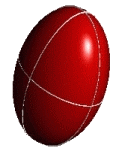[Uni Tübingen] - [Mat.-Nat. Fakultät] - [Fachbereich Chemie] - [Anorg. Chemie] - [Klaus Eichele] - [NMR Ramblings] - [Tensor Conventions] - Quadrupolar Tensors
 |
Quadrupolar Tensor ConventionsContents: [Quadrupolar interaction] - [Quadrupolar tensor] |
Quadrupolar Interaction
A quadrupolar nucleus S, with nuclear spin S > 1/2, is subject to an interaction of the nuclear quadrupole moment, eQ, with the component of the electric field gradient (EFG) along a particular direction, Vii = eqii. The Laplace equation requires that the trace of the EFG tensor is zero. In addition, the EFG tensor is symmetric, hence consists only of 5 independent components. In its principal axis system (PAS), XYZ, the EFG tensor is diagonal and can be characterized by the three principal components VXX, VYY, VZZ. In nuclear quadrupole resonance (NQR), the principal components are labelled according to this convention:
|VZZ| >= |VYY| >= |VXX|
Quadrupolar Tensor
Because of the trace of zero, only two independent parameters are required to characterize the magnitudes of the principal components, and these are usually chosen to be VZZ and the dimensionless asymmetry parameter η. The product of VZZ and the nuclear quadrupole moment is known as the quadrupolar coupling constant, χ:
Quadrupolar coupling constant:
Asymmetry parameter:
Thus, η is constrained to values between 0 and 1. The quadrupolar coupling constant should not be mixed up with the quadrupolar frequency, observed in NQR experiments.
My programs use this convention!
Some parameters can be evaluated on my page on Quadrupolar Parameters. Also, I recommend visiting Pascal Man's page an Quadrupole Coupling in NMR.
Most authors are in agreement with this convention:
- In the first edition, Abragam [1] gives alternate conventions on p. 166 and p. 232; but from the context, especially the definition of eta, it is clear that the ordering is in error. In the revised edition, the error got corrected on page 232, but was overlooked on p. 166.
- Others following this convention are: Lucken, p. 36 [2]; Cohen and Reif, p. 333 [3]; Das and Hahn, p. 4 [4]; Man [5]
- The papers by Olivieri et al. (actually, he reports the convention only in one paper [6]) but the rest seems to be consistent). An exception is the review by Harris and Olivieri, p. 437 [7]: "...where, as usual, qzz >= qxx >= qyy ...". However, from the context it appears that the convention given above should have been used.
Conventions that differ can be found in:
- Spiess, p. 74 [8] uses a different convention, but he points out that this is for reasons of generality and more appropriate for treating shielding tensors.
- Vega, p. 3883 [9] uses a different convention
The program SIMPSON by M. Bak uses the convention where qxx >= qyy, different from the NQR community. To compensate this, one can add 90 deg to one of the Euler angles, alpha or gamma, depending on the actual situation.
References
[ Anorg. Chemie ] | [ Go Home ] | webm@ster | last modified: 16.04.2020

